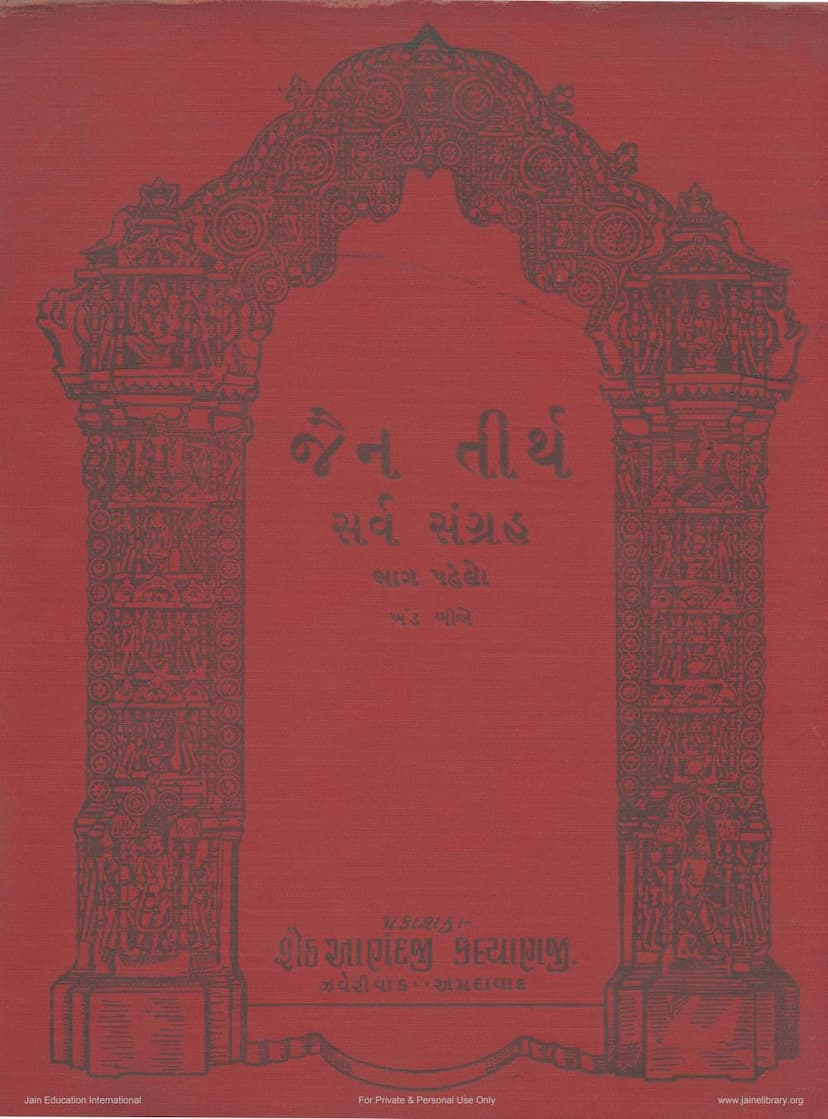Jain Tirth Sarva Sangraha
Added to library: September 2, 2025

Summary
Based on the provided Gujarati text excerpts from "Jain Tirth Sarva Sangraha" by Anandji Kalyanji Pedhi, here's a comprehensive summary in English:
Book Title: Jain Tirth Sarva Sangraha (A Compendium of Jain Holy Places) Author: Anandji Kalyanji Pedhi (Implied by Publisher) Publisher: Anandji Kalyanji Pedhi Catalog Link: https://jainqq.org/explore/004879/1
Overall Purpose:
The "Jain Tirth Sarva Sangraha" is a monumental work aimed at documenting and providing detailed information about Jain pilgrimage sites (Tirthas) across India. It serves as a comprehensive guide for pilgrims, researchers, historians, and anyone interested in the rich heritage of Jainism, its architectural marvels, and its historical spread.
Key Themes and Content (Based on the provided pages):
-
Primacy and Significance of Jainism: The text emphasizes the ancient origins, profound philosophical insights, and artistic contributions of Jainism within the broader context of Indian religions. It highlights that Jain Tirthas themselves are symbols of this ancient, grand, and liberal tradition, a fact acknowledged by both Indian and European scholars.
-
Pilgrimage and Devotion: The book acknowledges the daily practice of Jains across India (from children to the elderly) reciting "Sakala Tirtha Vandu Kar Jord" (Salutations to all holy places with folded hands). This highlights the natural curiosity and enthusiasm Jains have for knowing about these Tirthas and temples spread across the vast landscape of India.
-
Historical Context and Research: The text notes that post-independence India is actively exploring its identity. Jainism's significant architectural sites have garnered special attention from historians and archaeologists who are connecting the fragmented historical links of India's grand past by focusing on this glorious Jain heritage. The book acknowledges a long-standing demand from researchers for a universally accessible compilation of information about these great Tirthas.
-
Methodology and Scope:
- Extensive Research: The project for this information-rich book had been under consideration for about a decade. The task was substantial, involving significant responsibility and risk, especially for an institution like Anandji Kalyanji Pedhi. The effort to gather comprehensive and universally accepted facts was likened to "filling an ocean in a pitcher."
- Fieldwork: To collect information, a dedicated department was established. Researchers were dispatched to various regions of India. They traveled by rail, car, motor, bullock cart, and on foot to gather data from authentic sources.
- Information Gathering: The collection of detailed information about the locations (village, place, address etc.) of Tirthas was overseen by Shri Sarabhai Manilal Nawab. Pandit Shri Ambalal Premchand Shah was instrumental in preparing special notes.
- Compilation and Curation: After data collection, a rigorous process of refinement and purification was undertaken. Great care was taken to ensure that no essential facts were missed, no unnecessary information was included, and that factual accuracy was maintained without introducing controversial statements. The editing process was meticulous.
- Printing and Quality: Special attention was paid to the printing and paper quality, requiring significant effort and time to procure the appropriate paper. The printing process itself was carried out with diligence to ensure clarity, cleanliness, and neatness.
-
Content and Structure:
- Scope: The book covers Jain Tirthas from the perspective of Shvetambara Jains. It also includes ancient villages and towns that may not be Tirthas but are historically significant, modern Tirthas, and places where significant Jain events have occurred, contributing to cultural development.
- Number of Sites: The compilation includes information on approximately 270 primary sites, along with 110 fragmented, forgotten, or lost locations, totaling around 380 places.
- Appendices: The book includes seven types of subject indexes in the appendices.
- Regional Coverage: The descriptions are organized geographically, covering Gujarat, Marwar, Mewar, Malwa, Sindh-Punjab, South India, Madhya Pradesh, Uttar Pradesh, Bihar-Bengal, Assam, and Orissa.
- Information Provided: For each location, the book details its historical significance, current status, historical details, inscriptions, ancient literature references (Agam Granthas, Bhashyas, Niryuktis, Churnis, Tikkas), literary works, travel accounts, archaeological findings, and the decisions of archaeologists. It also strives to provide information on the architecture, sculptures, and religious significance, including cave temples.
- Historical Depth: The compilation attempts to provide a glimpse into the development and spread of Jainism in different regions, touching upon geographical information, Jain influence, temple conditions, sculptural details, and important events chronologically.
-
Key Individuals Acknowledged: The publication acknowledges the assistance of Shri Sarabhai Manilal Nawab and his associates for collecting material, Pandit Shri Ambalal Premchand Shah for preparing detailed notes, Vasant Printing Press and Shri Jayantilal Dalal for printing, Shri Jaybhikkhu for valuable guidance, and Shri Mohanlal bhai of M/s M. Vadhilal & Co. for their help.
-
User Acknowledgement: The publication expresses hope that the book will be useful and inspiring to enthusiasts, pilgrims, history lovers, archaeologists, and travelers. It also humbly acknowledges that despite meticulous efforts, errors and omissions might have occurred, and requests readers to point them out for improvement in future editions.
In essence, "Jain Tirth Sarva Sangraha" is presented as a scholarly and extensive effort to preserve and disseminate knowledge about the vital Jain pilgrimage sites, reflecting the depth of Jain history, art, and devotion across India. The provided pages focus on introducing the book's purpose, methodology, and its comprehensive scope, with a particular emphasis on the historical and cultural significance of Jainism in regions like Rajasthan.